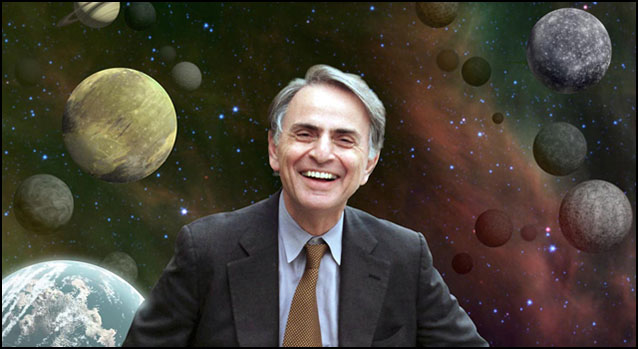816 Carl Sagan: Cosmos
This page is a tribute to legendary astronomer, cosmologist, public science educator and author of one of my favourite books: Cosmos ... Carl Sagan. Just check this out:
“The
thing that I find most striking is the enormous, remarkable capability of
virtually every small child for learning. They start out eager, intellectually
wide-eyed, asking extremely clever questions about the world, and then
something happens by and large, to discourage them, and I think it’s a
tremendous waste of national resources.
For example, a kid asks, “Mummy, why is
the grass green?” And very often you get an answer, “oh don’t ask dumb
questions” or “who knows" when in fact it’s a profound question.
How much better would it be to say to the child, “that’s a good question, I
don’t know the answer, maybe we can look it up,” or “nobody knows, maybe when
you grow up you’ll be the person to find out.”
I think kids who are discouraged
from asking those questions wind up learning the lesson, that there is
something bad about using the mind and we lose resources and we need those
intellectual resources, because, we are in very perilous times … and we
need people able to think.”

From Wikipedia:
Carl Edward Sagan (November 9, 1934 – December 20, 1996) was an American astronomer, cosmologist, astrophysicist, astrobiologist, author, science popularizer, and science communicator in astronomy and other natural sciences. He is best known for his work as a science popularizer and communicator. His best known scientific contribution is research on extraterrestrial life, including experimental demonstration of the production of amino acids from basic chemicals by radiation.
Sagan assembled the first physical messages sent into space: the Pioneer plaque and the Voyager Golden Record, universal messages that could potentially be understood by any extraterrestrial intelligence that might find them. Sagan argued the now accepted hypothesis that the high surface temperatures of Venus can be attributed to and calculated using the greenhouse effect.
Sagan published more than 600 scientific papers and articles and was author, co-author or editor of more than 20 books. He wrote many popular science books, such as The Dragons of Eden, Broca's Brain and Pale Blue Dot, and narrated and co-wrote the award-winning 1980 television series Cosmos: A Personal Voyage.
The most widely watched series in the history of American public television, Cosmos has been seen by at least 500 million people across 60 different countries. The book Cosmos was published to accompany the series. He also wrote the science fiction novel Contact, the basis for a 1997 film of the same name. His papers, containing 595,000 items, are archived at The Library of Congress.
Below some of my favourite YouTube videos on Sagan, science and cosmology. Admittedly the videos seem dated today ... they are about 35 or more years old.
Sagan was "the first celebrity astronomer, because he was the one man who could explain it all; he made the complexities of the universe understandable, he made the cosmos fascinating." That was then, of course ... these days we have Prof. Brian Cox, who took over the mantle of "the man who could explain cosmology" on tv.
I have an essay COSMOS in my book with no title, instead three definitions for the term en.light.en.ment